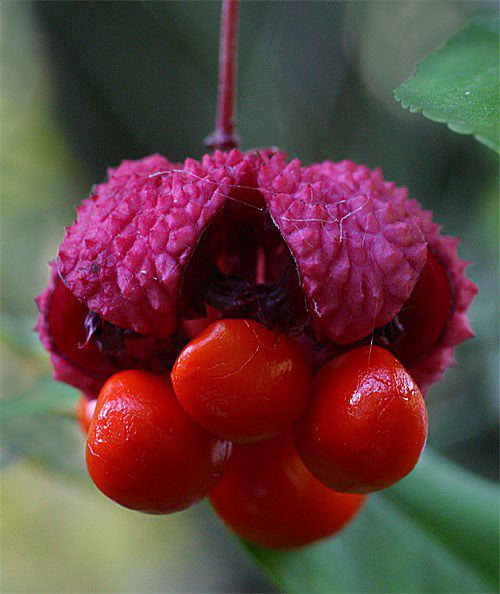|
|
|||
|
|
|||
Back to Preceding Week; on to Next Week
|
STRAWBERRY-BUSH Within the next fortnight, most deciduous trees in the Carolina Piedmont will begin to shut down warm-weather functions in anticipation of the inevitable cold, dark days of winter. In particular, water and minerals will cease to flow from twig to leaf, and dying foliage will reveal those brightly colored yellow and orange pigments that in spring and summer were masked by green chlorophyll. Tens of thousands of fall foliage watchers across the eastern U.S. will drive to the mountains or New England to see this annual autumnal spectacle, but we doubt anyone will observe anything quite as bright as what we're already enjoying here at Hilton Pond Center--the brilliant scarlet berries of Strawberry-bush. 
All text & photos © Hilton Pond Center Strawberry-bush is a shade-loving shrub that goes unnoticed for much of the year. In late spring, careful observers will spy its unusual greenish- white blossoms tinged with pink or purple. These quarter-inch five- petaled flowers (below right) are so flat they're almost two-dimensional, and they often form on thin paired stalks. Strawberry-bush likewise caught the eye of early botanists who visited the New World, so much so that in 1663 it was among the first American plants exported back to Europe for horticultural use. Another striking characteristic of Strawberry-bush is its opposite green branches and twigs (below right). Except in old main trunks, the bark remains smooth and unfragmented such that the green color stands out against the brown and seemingly lifeless winter woods. Deer appear to have a special fondness for these green twigs--they're even called "deer ice cream"-- Strawberry-bush is in the Bittersweet or Staff-Tree Family (Celastraceae), which has few representatives in North America. Its scientific epithet, Euonymus americanus, is derived from words meaning "good name," and is shared by a related plant called the Wahoo, E. atropurpureus; this purple-fruited tree-shrub is rare in the Carolinas but common in the eastern and central U.S. west of the Appalachians and north of coastal states. Two imported species, Burning Bush (E. alatus) and Spindletree (E. europaeus), are grown frequently as ornamentals and often escape--sometimes to the detriment of less- competitive native shrub species. Many authorities report that the fruit and bark of the Strawberry-bush and its relatives contain glycosides that cause severe diarrhea in humans; Strawberry-bushes often grow along shaded streams, in river bottoms, or in moist open woods across the eastern U.S. and into Texas, so the vegetated banks of Hilton Pond appear to be an ideal habitat. We're glad of that, and rather than driving off to the mountains to watch the leaves change color we'll stay home and spend the next month taking pleasure from the smaller spectacle of our very own Strawberry-bush with its brilliant scarlet berries. "This Week at Hilton Pond" is written and photographed by Bill Hilton Jr., executive director of Hilton Pond Center for Piedmont Natural History. You may wish to consult our Index of all nature topics covered since February 2000. You can also use the on-line Search Engine at the bottom of this page. For a free, non-fattening, on-line subscription to "This Week at Hilton Pond," just send us an E-mail with Subscribe in the subject line. Please be sure to configure your spam filter to accept E-mails from hiltonpond.org. |
|
Make direct donations on-line through
Network for Good: |
|
|
LIKE TO SHOP ON-LINE?
Donate a portion of your purchase price from 500 top on-line stores via iGive: |
|
|
Use your PayPal account to make direct donations:
|
|
|
|
|
SPECIES BANDED THIS WEEK: * = New species for 2003 WEEKLY BANDING TOTAL 17 species 38 individuals YEARLY BANDING TOTAL (2003) 55 species 921 individuals BANDING GRAND TOTAL (since 28 June 1982) 123 species 43.035 individuals NOTABLE RECAPTURES THIS WEEK (with original banding date, sex, and current age) Carolina Chickadee (1) Tufted Titmouse (1) VAGRANT HUMMINGBIRDS None this week |
OTHER SIGHTINGS OF INTEREST HUMMINGBIRD NOTES |
|
|
|
Up to Top of Page Back to This Week at Hilton Pond Center Current Weather Conditions at Hilton Pond Center |
|
Join the |
 post questions for The Piedmont Naturalist |
Join the |
Search Engine for |
|
|